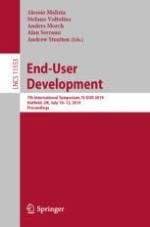This book constitutes the refereed proceedings of the 7th International Symposium on End-User Development, IS-EUD 2017, held in Hatfield, UK, in July 2019.
The 9 full papers and 8 short papers presented were carefully reviewed and selected from 35 submissions. The papers discuss progress in research around end-user development through, or towards, methods, socio-technical environments, intelligent agents, as well as the most effective end-user programming paradigms for smart environments. Papers and submissions in all categories addressed this specific theme together with topics that have been traditionally covered by the broader themes of end-user development, such as domain specific tools, spreadsheets, educational applications, and end user aspects.
